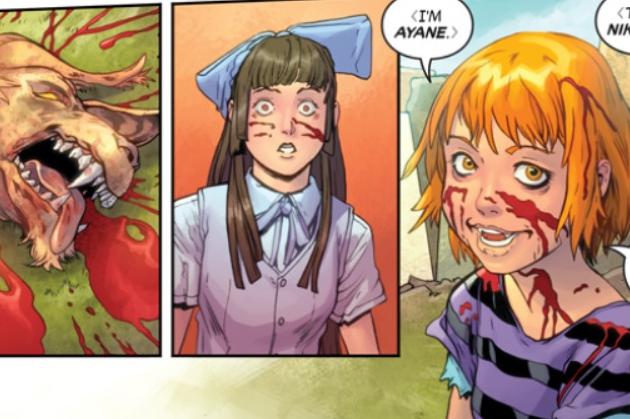Wayward #6
Written by: Jim Zub
Art by: Steve Cummings
Colors by: Tamra Bonvillain
Letters by: Marshall Dillon
Back Matter by: Zack Davisson
After a few months off, Wayward is finally back and it feels good. The first arc quickly established Wayward as one of my favorite comics for a variety of reasons. It wasn't just the writing and art that drew me in. It was the themes of loneliness and isolation. The vibrant characters who felt very realized even though a new one was introduced every issue. While there were certainly faults in the first arc, I found them to be minor ones that didn't inhibit the joy I felt while reading.
So here we are with Issue #6, does it live up to my unrelenting hype? Yes.
Taking place 3 months after the first arc ends, issue #6 picks up with introducing yet ANOTHER new character named Ohara Emi. Ohara is immediately portrayed as a girl that is stuck going through the motions and as she looks ahead towards the rest of her life that is all she sees. She's very good at following patterns (possibly a reference to Rori?) however, she can't seem to escape them. The entire plot of this issue revolves around Ohara and mirrors a lot of the first issue which featured Rori's first experiences in Japan. I'm curious to know why Jim Zub scripted it this way and if we'll see warped mirror images of the other four first arc issues in this second arc. There's a scene at the end where Ayane shows up with Nikaido for a well done action scene, it mirrors the first issue where Ayane comes to Rori's rescue. However, the tone is entirely different. In the first issue, the fight is thrilling, but there's a sense of whimsy and fun to it. In issue #6, it devolves into a twisted bloodbath that left me in minor state of shock.
However gruesome Wayward is becoming, it's all beautifully rendered by Steve Cummings and Tamra Bonvillain. Pages are visually dynamic and interesting to look at on their own as a pieces of art. This art team lays waste to so many other books. I can't wrap my head around how they're able to produce pages of this quality so quickly. If this book released once every other month that would make more sense, but it's just incredible to think they do this on a near monthly basis.
To top it all off, Wayward features a wonderful essay in the back of the issue by Zack Davisson about obligation versus personal desire. It's always interesting to read his essays. They help to underscore the chapters and open up the setting to the reader, who might not be entirely familiar with Japanese culture.
Basically, in the simplest terms, READ THIS BOOK.
Art by: Steve Cummings
Colors by: Tamra Bonvillain
Letters by: Marshall Dillon
Back Matter by: Zack Davisson
After a few months off, Wayward is finally back and it feels good. The first arc quickly established Wayward as one of my favorite comics for a variety of reasons. It wasn't just the writing and art that drew me in. It was the themes of loneliness and isolation. The vibrant characters who felt very realized even though a new one was introduced every issue. While there were certainly faults in the first arc, I found them to be minor ones that didn't inhibit the joy I felt while reading.
So here we are with Issue #6, does it live up to my unrelenting hype? Yes.
Taking place 3 months after the first arc ends, issue #6 picks up with introducing yet ANOTHER new character named Ohara Emi. Ohara is immediately portrayed as a girl that is stuck going through the motions and as she looks ahead towards the rest of her life that is all she sees. She's very good at following patterns (possibly a reference to Rori?) however, she can't seem to escape them. The entire plot of this issue revolves around Ohara and mirrors a lot of the first issue which featured Rori's first experiences in Japan. I'm curious to know why Jim Zub scripted it this way and if we'll see warped mirror images of the other four first arc issues in this second arc. There's a scene at the end where Ayane shows up with Nikaido for a well done action scene, it mirrors the first issue where Ayane comes to Rori's rescue. However, the tone is entirely different. In the first issue, the fight is thrilling, but there's a sense of whimsy and fun to it. In issue #6, it devolves into a twisted bloodbath that left me in minor state of shock.
However gruesome Wayward is becoming, it's all beautifully rendered by Steve Cummings and Tamra Bonvillain. Pages are visually dynamic and interesting to look at on their own as a pieces of art. This art team lays waste to so many other books. I can't wrap my head around how they're able to produce pages of this quality so quickly. If this book released once every other month that would make more sense, but it's just incredible to think they do this on a near monthly basis.
To top it all off, Wayward features a wonderful essay in the back of the issue by Zack Davisson about obligation versus personal desire. It's always interesting to read his essays. They help to underscore the chapters and open up the setting to the reader, who might not be entirely familiar with Japanese culture.
Basically, in the simplest terms, READ THIS BOOK.





